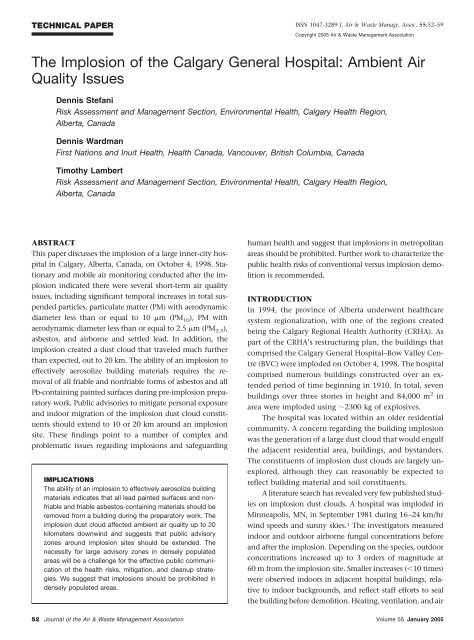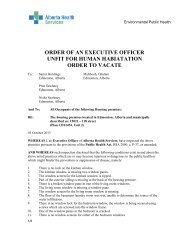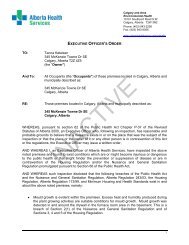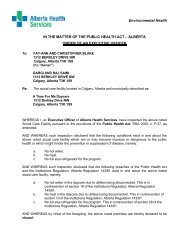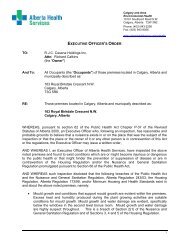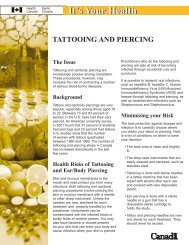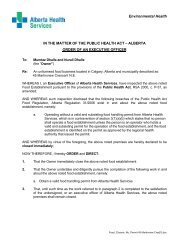The Implosion of the Calgary General Hospital - Alberta Health ...
The Implosion of the Calgary General Hospital - Alberta Health ...
The Implosion of the Calgary General Hospital - Alberta Health ...
You also want an ePaper? Increase the reach of your titles
YUMPU automatically turns print PDFs into web optimized ePapers that Google loves.
TECHNICAL PAPER<br />
<strong>The</strong> <strong>Implosion</strong> <strong>of</strong> <strong>the</strong> <strong>Calgary</strong> <strong>General</strong> <strong>Hospital</strong>: Ambient Air<br />
Quality Issues<br />
Dennis Stefani<br />
Risk Assessment and Management Section, Environmental <strong>Health</strong>, <strong>Calgary</strong> <strong>Health</strong> Region,<br />
<strong>Alberta</strong>, Canada<br />
Dennis Wardman<br />
First Nations and Inuit <strong>Health</strong>, <strong>Health</strong> Canada, Vancouver, British Columbia, Canada<br />
Timothy Lambert<br />
Risk Assessment and Management Section, Environmental <strong>Health</strong>, <strong>Calgary</strong> <strong>Health</strong> Region,<br />
<strong>Alberta</strong>, Canada<br />
ABSTRACT<br />
This paper discusses <strong>the</strong> implosion <strong>of</strong> a large inner-city hospital<br />
in <strong>Calgary</strong>, <strong>Alberta</strong>, Canada, on October 4, 1998. Stationary<br />
and mobile air monitoring conducted after <strong>the</strong> implosion<br />
indicated <strong>the</strong>re were several short-term air quality<br />
issues, including significant temporal increases in total suspended<br />
particles, particulate matter (PM) with aerodynamic<br />
diameter less than or equal to 10 m (PM 10), PM with<br />
aerodynamic diameter less than or equal to 2.5 m (PM 2.5),<br />
asbestos, and airborne and settled lead. In addition, <strong>the</strong><br />
implosion created a dust cloud that traveled much fur<strong>the</strong>r<br />
than expected, out to 20 km. <strong>The</strong> ability <strong>of</strong> an implosion to<br />
effectively aerosolize building materials requires <strong>the</strong> removal<br />
<strong>of</strong> all friable and nonfriable forms <strong>of</strong> asbestos and all<br />
Pb-containing painted surfaces during pre-implosion preparatory<br />
work. Public advisories to mitigate personal exposure<br />
and indoor migration <strong>of</strong> <strong>the</strong> implosion dust cloud constituents<br />
should extend to 10 or 20 km around an implosion<br />
site. <strong>The</strong>se findings point to a number <strong>of</strong> complex and<br />
problematic issues regarding implosions and safeguarding<br />
IMPLICATIONS<br />
<strong>The</strong> ability <strong>of</strong> an implosion to effectively aerosolize building<br />
materials indicates that all lead painted surfaces and nonfriable<br />
and friable asbestos-containing materials should be<br />
removed from a building during <strong>the</strong> preparatory work. <strong>The</strong><br />
implosion dust cloud affected ambient air quality up to 20<br />
kilometers downwind and suggests that public advisory<br />
zones around implosion sites should be extended. <strong>The</strong><br />
necessity for large advisory zones in densely populated<br />
areas will be a challenge for <strong>the</strong> effective public communication<br />
<strong>of</strong> <strong>the</strong> health risks, mitigation, and cleanup strategies.<br />
We suggest that implosions should be prohibited in<br />
densely populated areas.<br />
ISSN 1047-3289 J. Air & Waste Manage. Assoc. 55:52–59<br />
Copyright 2005 Air & Waste Management Association<br />
human health and suggest that implosions in metropolitan<br />
areas should be prohibited. Fur<strong>the</strong>r work to characterize <strong>the</strong><br />
public health risks <strong>of</strong> conventional versus implosion demolition<br />
is recommended.<br />
INTRODUCTION<br />
In 1994, <strong>the</strong> province <strong>of</strong> <strong>Alberta</strong> underwent healthcare<br />
system regionalization, with one <strong>of</strong> <strong>the</strong> regions created<br />
being <strong>the</strong> <strong>Calgary</strong> Regional <strong>Health</strong> Authority (CRHA). As<br />
part <strong>of</strong> <strong>the</strong> CRHA’s restructuring plan, <strong>the</strong> buildings that<br />
comprised <strong>the</strong> <strong>Calgary</strong> <strong>General</strong> <strong>Hospital</strong>–Bow Valley Centre<br />
(BVC) were imploded on October 4, 1998. <strong>The</strong> hospital<br />
comprised numerous buildings constructed over an extended<br />
period <strong>of</strong> time beginning in 1910. In total, seven<br />
buildings over three stories in height and 84,000 m 2 in<br />
area were imploded using 2300 kg <strong>of</strong> explosives.<br />
<strong>The</strong> hospital was located within an older residential<br />
community. A concern regarding <strong>the</strong> building implosion<br />
was <strong>the</strong> generation <strong>of</strong> a large dust cloud that would engulf<br />
<strong>the</strong> adjacent residential area, buildings, and bystanders.<br />
<strong>The</strong> constituents <strong>of</strong> implosion dust clouds are largely unexplored,<br />
although <strong>the</strong>y can reasonably be expected to<br />
reflect building material and soil constituents.<br />
A literature search has revealed very few published studies<br />
on implosion dust clouds. A hospital was imploded in<br />
Minneapolis, MN, in September 1981 during 16–24 km/hr<br />
wind speeds and sunny skies. 1 <strong>The</strong> investigators measured<br />
indoor and outdoor airborne fungal concentrations before<br />
and after <strong>the</strong> implosion. Depending on <strong>the</strong> species, outdoor<br />
concentrations increased up to 3 orders <strong>of</strong> magnitude at<br />
60 m from <strong>the</strong> implosion site. Smaller increases (10 times)<br />
were observed indoors in adjacent hospital buildings, relative<br />
to indoor backgrounds, and reflect staff efforts to seal<br />
<strong>the</strong> building before demolition. Heating, ventilation, and air<br />
52 Journal <strong>of</strong> <strong>the</strong> Air & Waste Management Association Volume 55 January 2005
Figure 1. Map <strong>of</strong> <strong>the</strong> Bow Valley Centre implosion site showing stationary monitoring locations, <strong>Calgary</strong>, <strong>Alberta</strong>.<br />
conditioning systems were operated in <strong>the</strong> 100% recirculation<br />
mode, and <strong>the</strong> outdoor air intakes were sealed.<br />
Anecdotally, <strong>the</strong> Baltimore City <strong>Health</strong> Department 2<br />
and Las Vegas County 3 reported large implosion dust<br />
clouds that dissipated in 20–30 min at 1 km distance.<br />
Reported PM 10 concentrations in <strong>the</strong> dust cloud ranged<br />
from 150 to 200 g/m 3 . Thick dust coatings on nearby<br />
vehicles and buildings suggest that very large particulates<br />
quickly settled out <strong>of</strong> <strong>the</strong> dust cloud.<br />
Because some dust was anticipated from <strong>the</strong> implosion,<br />
residents within 1 km surrounding <strong>the</strong> BVC were<br />
advised to close windows and doors, seal <strong>the</strong>m, and leave<br />
<strong>the</strong> area to mitigate any exposures. This distance was<br />
based on anecdotal information that <strong>the</strong> dust cloud<br />
would dissipate within 1 km <strong>of</strong> <strong>the</strong> implosion site. Contrary<br />
to this advice, many people congregated around <strong>the</strong><br />
site in a festive atmosphere to witness <strong>the</strong> implosion.<br />
Before <strong>the</strong> implosion, all friable and some nonfriable<br />
asbestos was removed from <strong>the</strong> structures. Lead (Pb)<br />
present in <strong>the</strong> paint because <strong>of</strong> <strong>the</strong> age <strong>of</strong> <strong>the</strong> building was<br />
assumed to have an insignificant impact on air quality or<br />
deposition. Because <strong>of</strong> <strong>the</strong> limited literature on implosions,<br />
<strong>the</strong>se findings can be a useful planning tool for<br />
managing future implosions and future research.<br />
OBJECTIVES<br />
<strong>The</strong> study addressed four null hypo<strong>the</strong>ses: (1) <strong>the</strong> implosion<br />
<strong>of</strong> <strong>the</strong> BVC will generate a pollutant cloud above<br />
ambient guidelines within 1 km <strong>of</strong> <strong>the</strong> implosion site; (2)<br />
<strong>the</strong>re will be insignificant ambient levels and public<br />
health risks from Pb and asbestos within 1 km <strong>of</strong> <strong>the</strong> site<br />
Stefani, Wardman, and Lambert<br />
because <strong>of</strong> <strong>the</strong> removal <strong>of</strong> friable and some nonfriable<br />
asbestos and <strong>the</strong> assumption <strong>of</strong> negligible Pb; (3) <strong>the</strong><br />
implosion cloud will not affect ambient air quality beyond<br />
1 km; and (4) <strong>the</strong> implosion will not result in an<br />
elevated health risk for residents beyond 1 km.<br />
<strong>The</strong> hypo<strong>the</strong>ses were tested by measuring pre-implosion,<br />
implosion, and post-implosion air quality for total<br />
suspended particles (TSP), airborne asbestos, and airborne<br />
and deposited Pb. <strong>The</strong> dynamics <strong>of</strong> <strong>the</strong> implosion dust cloud<br />
dissipation was followed with time in terms <strong>of</strong> TSP, inhalable<br />
PM 10 (particle size 10 m diameter), and respirable<br />
PM 2.5 (particle size 2.5 m diameter). <strong>The</strong> concentrations<br />
<strong>of</strong> <strong>the</strong> pollutants generated in <strong>the</strong> implosion were compared<br />
against guidelines indicating potential public health risks.<br />
METHODS<br />
Air Monitoring<br />
Fixed and mobile air monitoring occurred before, during,<br />
and post-implosion. Fixed air sampling locations for TSP<br />
(<strong>Alberta</strong> Environment Method A-8–1), PCM (Phase Contrast<br />
Microscopy) asbestos (National Institute for Occupational<br />
Safety and <strong>Health</strong> [NIOSH] #7400), transmission electron<br />
microscopy (TEM) asbestos (NIOSH #7402), Pb (U.S. Environmental<br />
Protection Agency Method #3051), and surfacedeposited<br />
Pb (U.S. Department <strong>of</strong> Housing and Urban Development<br />
[HUD] Title X) are shown in Figure 1. <strong>The</strong><br />
hospital occupies a large area <strong>of</strong> <strong>the</strong> primary evacuation<br />
zone identified in <strong>the</strong> figure. <strong>Alberta</strong> Environment’s mobile<br />
monitoring vehicle was used to record TSP, PM10, and PM2.5 (Grimm 1.105 laser dispersion). Ambient air quality<br />
data also were obtained from <strong>the</strong> permanent <strong>Alberta</strong><br />
Volume 55 January 2005 Journal <strong>of</strong> <strong>the</strong> Air & Waste Management Association 53
Stefani, Wardman, and Lambert<br />
Environment air monitoring station located 2 km southwest<br />
in downtown <strong>Calgary</strong>.<br />
Fixed sampling consisted <strong>of</strong> background 24-hr average<br />
concentrations before <strong>the</strong> blast, during, and immediately<br />
after <strong>the</strong> implosion (measured concentrations between<br />
8:00 a.m. and 11:00 a.m. on October 4), postimplosion<br />
(between 11:00 a.m. and 8:00 a.m. <strong>the</strong> next<br />
day), and a calculated 24-hr average between 8:00 a.m. on<br />
October 4 and 8:00 a.m. on October 5). <strong>The</strong> implosion<br />
occurred October 4, 1998, at 8:00 a.m. <strong>Alberta</strong> Public<br />
Works, Supply & Services did all <strong>of</strong> <strong>the</strong> stationary sampling<br />
through <strong>the</strong>ir consultant, PHH Environmental. <strong>The</strong><br />
<strong>Alberta</strong> Environment mobile monitoring vehicle was used<br />
to follow visually <strong>the</strong> path <strong>of</strong> <strong>the</strong> dust cloud along its<br />
sou<strong>the</strong>astern course. Peak or maximum 1-min average<br />
concentrations were recorded from <strong>the</strong> vehicle.<br />
<strong>Health</strong> Risk Assessment<br />
<strong>The</strong> air quality data were compared with ambient air<br />
quality guidelines that were in place <strong>the</strong> year <strong>of</strong> <strong>the</strong> implosion<br />
(1998), and <strong>the</strong> analysis was updated with some<br />
current health risk information for acute exposures to<br />
PM2.5. Where <strong>the</strong>re were no <strong>Alberta</strong> standards or guidelines,<br />
those from o<strong>the</strong>r jurisdictions were utilized.<br />
• TSP, 100 g/m 3 24-hr average <strong>Alberta</strong> Ambient<br />
Air Quality Guideline as defined by <strong>Alberta</strong> Environment;<br />
• Airborne PCM asbestos fibers, 0.01 fibers/cm 3 ,<br />
which is <strong>the</strong> <strong>Alberta</strong> indoor air clearance criterion<br />
following asbestos abatement;<br />
• Airborne Pb, 5 g/m 3 24-hr average as defined by<br />
<strong>the</strong> Ontario government in <strong>the</strong> Ambient Air<br />
Quality Criteria Regulation; 4<br />
• Settled Pb dust as 500–800 g/ft 2 as defined by<br />
HUD5 for interior window stills and window<br />
troughs in homes; and<br />
• Mice lungs instilled with 100 g <strong>of</strong> World Trade<br />
Center (WTC) PM2.5 surface dust demonstrated<br />
lung inflammation and airway hyper-responsiveness<br />
with methacholine challenge, which was estimated<br />
to be equivalent to a human inhalation concentration<br />
<strong>of</strong> 450 g/m 3 . 6 <strong>The</strong> authors estimated<br />
that active healthy workers exposed to this concentration<br />
over an 8-hr period would develop lung<br />
inflammation, air hyper-responsiveness, and upper<br />
respiratory tract irritation. Hypersusceptibles, such<br />
as asthmatics, were thought to develop <strong>the</strong>se problems<br />
at lower doses. <strong>The</strong> NOAEL (No Observable<br />
Adverse Effect Level) in this study was a mouse dose<br />
<strong>of</strong> 31.6 g, equivalent to an 8-hr hard-working<br />
adult exposure <strong>of</strong> 134 g/m 3 .<br />
<strong>The</strong>re are numerous protocols for deriving reference<br />
concentrations or ambient air quality guidelines aimed at<br />
public health protection from animal studies. 7–9 Using <strong>the</strong><br />
NOAEL approach, it would not be unusual to apply up to an<br />
order <strong>of</strong> magnitude reduction to <strong>the</strong> dose-adjusted human<br />
equivalent concentration to account for hypersusceptibles<br />
in <strong>the</strong> human population. <strong>The</strong> experimental NOAEL dose<br />
for mice in <strong>the</strong> WTC study was 31.6 g for PM 2.5 dust,<br />
equivalent to a resting adult human inhalation concentration<br />
after 15-min exposure at 20 m 3 /day <strong>of</strong> 9200 g/m 3 .<br />
It would be prudent to lower this concentration to be<br />
protective <strong>of</strong> hypersusceptibles within <strong>the</strong> general population.<br />
In consideration <strong>of</strong> a possible 10 adjustment, <strong>the</strong><br />
recommended public health guideline for <strong>the</strong> prevention <strong>of</strong><br />
noncancer acute adverse respiratory effects from implosion<br />
dust cloud PM 2.5 is 920 g/m 3 for a short-term exposure <strong>of</strong><br />
15 min.<br />
<strong>The</strong> literature was searched to find methods for shortterm<br />
cancer risk assessment. Because none were found, cancer<br />
risk for asbestos exposure for <strong>the</strong> short period was amortized<br />
over a lifetime. An acute exposure factor was<br />
included to account for <strong>the</strong> increased potency <strong>of</strong> carcinogens<br />
with short-term exposure based on <strong>the</strong> observations <strong>of</strong><br />
short-term exposure to polycyclic aromatic hydrocarbons<br />
(PAHs) and development <strong>of</strong> cancer. Acute health risks for<br />
exposure to implosion dust were evaluated by comparison<br />
with <strong>the</strong> toxicological data from <strong>the</strong> dust generated from <strong>the</strong><br />
WTC collapse.<br />
RESULTS<br />
On <strong>the</strong> morning <strong>of</strong> <strong>the</strong> implosion, <strong>the</strong> wea<strong>the</strong>r conditions<br />
were as follows: clear sky, temperature 8 °C, and wind from<br />
<strong>the</strong> northwest at 7 km/hr (ground level). <strong>The</strong> results <strong>of</strong><br />
monitoring are displayed in Table 1 for <strong>the</strong> fixed air sampling<br />
locations and in Table 2 for <strong>the</strong> mobile monitoring.<br />
<strong>The</strong> fixed pre-implosion monitoring sample results established<br />
background concentrations <strong>of</strong> TSP, asbestos, and<br />
airborne and surface Pb (Tables 1 and 2). For mobile monitoring<br />
results, <strong>the</strong> permanently located <strong>Alberta</strong> Environment<br />
air monitoring station in downtown <strong>Calgary</strong> 2 km to<br />
<strong>the</strong> southwest provided additional estimates <strong>of</strong> background<br />
PM 10 and PM 2.5. Hourly average (range) PM 10 and PM 2.5<br />
concentrations for October 4 were 8.9 (5–12.5) and 5.3 (3.5–<br />
6.5) g/m 3 , respectively. For 1998, <strong>the</strong> hourly PM 10 average<br />
and 98th percentile concentrations were 32 and 127 g/m 3 .<br />
For PM 2.5 <strong>the</strong> average and 98th percentile were 13 and 38<br />
g/m 3 . <strong>The</strong> mobile van provided 1-min average background<br />
estimates <strong>of</strong> TSP, PM 10, and PM 2.5 levels during <strong>the</strong> preimplosion<br />
period and on <strong>the</strong> half-hour drive back to <strong>the</strong><br />
implosion site (9:32–10:05 a.m.) Average and (maximum)<br />
1-min TSP, PM 10, and PM 2.5 concentrations on <strong>the</strong> drive<br />
back were 47 (338), 35 (264), and 8 (51) g/m 3 , respectively.<br />
Pre-implosion background measurements were considerably<br />
lower and reflect <strong>the</strong> influence <strong>of</strong> <strong>the</strong> early morning<br />
hours and site security.<br />
54 Journal <strong>of</strong> <strong>the</strong> Air & Waste Management Association Volume 55 January 2005
Volume 55 January 2005 Journal <strong>of</strong> <strong>the</strong> Air & Waste Management Association 55<br />
Table 1. Stationary ambient air quality monitoring data (<strong>Alberta</strong> Public Works, Supply & Services).<br />
Parameter<br />
Sample Locations<br />
#1 #2 #3 #4 #5 #6 #7<br />
Distance from <strong>Implosion</strong> site (m)<br />
TSP, g/m<br />
300 west 50 north 200 nor<strong>the</strong>ast 50 east 400 sou<strong>the</strong>ast 50 south 550 east<br />
3<br />
Pre-implosion (24-hr averages for Sept 26/<br />
27/Oct 3) nd/nd/20.4 38.3/33.1/21.5 nd/nd/12.8 nd/nd/22 39.2/38.0/21.5 nd/nd/30 nd<br />
<strong>Implosion</strong> (Oct 4 8:00–11:00 AM) 34.6 27.4 23.3 11880.8 3273.4 27,406.6 5500 (22-min sample)<br />
Post-implosion (11:00–8:00 AM) 29.7 49.8 22 212.2 122.9 390.6 nd<br />
<strong>Implosion</strong> and post-implosion (24-hr average)<br />
Airborne PCM asbestos, fibers/cm<br />
30 46.8 22.1 1611.8 515.9 3093.5 nd<br />
3<br />
Pre-implosion (24-hr averages for Sept 26/<br />
27/Oct 3) nd/nd/ 0.001 0.001/0.001/ 0.001 nd/nd/ 0.001 nd/nd/nd/ 0.003 0.001/0.001/0.001 nd/nd/nd nd<br />
<strong>Implosion</strong> (8:00–11:00 AM) 0.013 0.006 0.023 0.128 0.065 0.362 1.88 (22-min sample)<br />
Post-implosion (11:00 AM-8:00 AM) 0.001 0.001 0.001 0.008 0.004 0.005 nd<br />
<strong>Implosion</strong> and post-implosion (24-hr average)<br />
Airborne TEM asbestos, fibers/cm<br />
0.002 0.002 0.002 0.024 0.012 0.047 nd<br />
3<br />
Pre-implosion (24-hr averages for Sept 26/<br />
27) nd 0.001/ 0.001 nd nd 0.001/0.001 nd nd<br />
<strong>Implosion</strong> (8:00–11:00 AM) nd nd nd 0.02 nd 0.09 0.08 (22-min sample)<br />
Post-<strong>Implosion</strong> (11:00 AM-8:00 AM) nd nd nd nd nd 0.0003 nd<br />
<strong>Implosion</strong> and post-implosion (24-hr average)<br />
Airborne Pb, g/m<br />
nd nd nd nd nd 0.009 nd<br />
3<br />
Pre-implosion (24-hr average Sept 26/Oct 3) nd 0.004/nd nd nd/0.003 0.004/0.003 nd/0.006 nd<br />
<strong>Implosion</strong> (8:00–11:00 AM) nd nd nd 4.5 nd 4.29 nd<br />
Post-<strong>Implosion</strong> (11:00–8:00 AM) nd nd nd 0.04 nd 0.07 nd<br />
<strong>Implosion</strong> and post-implosion (24-hr average)<br />
Pb in settled dust (wipe sampling), g/ft<br />
nd nd nd 0.58 nd 0.49 nd<br />
2<br />
Pre-implosion (Oct 3) 25 107 25 25 25 25 nd<br />
Post-implosion (Oct 4) 25 55 25 239 44 1347 (retest 1548) nd<br />
nd no data<br />
Stefani, Wardman, and Lambert
Stefani, Wardman, and Lambert<br />
Table 2. Mobile air monitoring data summary (<strong>Alberta</strong> Environment).<br />
Location Time<br />
Based on <strong>the</strong> stationary monitoring results, hypo<strong>the</strong>sis<br />
1 is accepted; a pollutant cloud above ambient guidelines<br />
within 1 km <strong>of</strong> <strong>the</strong> site was observed. <strong>The</strong> <strong>Alberta</strong><br />
ambient air quality guideline for <strong>the</strong> 24-hr average<br />
implosion and post-implosion TSP was exceeded at<br />
locations 4, 5, 6, and likely 7, all within 1 km and downwind<br />
(sou<strong>the</strong>ast) from <strong>the</strong> implosion (Figure 1).<br />
Based on stationary monitoring results, <strong>the</strong> hypo<strong>the</strong>sis<br />
that <strong>the</strong>re would be insignificant levels <strong>of</strong> airborne and<br />
deposited Pb and airborne asbestos within 1 km is rejected.<br />
PCM asbestos concentrations exceeded airborne criteria at a<br />
number <strong>of</strong> downwind locations (Table 1). A number <strong>of</strong><br />
exceedence samples were reanalyzed for TEM asbestos. Reanalysis<br />
results showed that <strong>the</strong> TEM asbestos concentrations<br />
were elevated at a number <strong>of</strong> downwind locations for<br />
<strong>the</strong> 3-hr monitoring period immediately following <strong>the</strong> implosion<br />
but were all below <strong>the</strong> guideline for calculated 24-hr<br />
average. <strong>The</strong> 24-hr average post-implosion airborne lead<br />
concentrations were elevated compared with normal background<br />
levels but were not above <strong>the</strong> 24-hr guideline. Wipe<br />
test results for Pb in settled dust ranged from “below detection<br />
limits” to a high <strong>of</strong> 1347 g/ft 2 at location #6 (Table 1).<br />
<strong>The</strong> elevated Pb wipe sample at location #4 is equivalent to<br />
a soil mass concentration <strong>of</strong> 10–15 ppm (assuming 1-cmdeep<br />
soil), which is roughly equivalent to background soil<br />
Average (Maximum) 1-Min Concentration<br />
TSP (g/m 3 ) PM 10 (g/m 3 ) PM 2.5 (g/m 3 )<br />
Comments<br />
Pre-implosion, 500 m from site (sou<strong>the</strong>ast) 5:00 AM–8:00 AM 6.5 4 1 Background<br />
(99) (15) (2)<br />
<strong>Implosion</strong> occurs 8:08 AM<br />
Post-implosion (PI), 500 m from site 8:14 AM 99,999 99,999 14,456 Location intermediate<br />
8:16 AM (86,179) (68,942) (7363) between stationary<br />
locations #7 and #5<br />
Average between 68,522 (includes 60,663 (includes 7516 <strong>The</strong> bulk <strong>of</strong> <strong>the</strong> dust cloud<br />
8:12 AM and 8:19 AM 99,999 99,999<br />
passed over monitoring<br />
measurements) measurements)<br />
van in 7 min<br />
PI, 2.5 km from site 8:21 AM (15,244) (9571) (785) Fluctuating values caused<br />
PI, 3 km from site 8:23–8:24 AM 15,412 (17,692) 9050 (11,005) 1674 (2367) by <strong>the</strong> difficulty in<br />
PI, 6 km from site 8:33–8:38 AM 5203 (7767) 4049 (5859) 630 (825) tracking and staying in<br />
PI, 8 km from site 8:42–8:43 AM 923 (1047) 740 (797) 175 (190) <strong>the</strong> dust cloud<br />
PI, 13 km from site 8:51–855 AM 1817 (2858) 1351 (2101) 242 (288)<br />
PI, 17 km from site 9:03–9:04 AM 1821 (2264) 1394 (1709) 227 (253)<br />
PI, 20 km from site 9:17–9:19 AM 1100 (1237) 873 (965) 152 (154)<br />
PI, 25 km from site 9:28 AM (2632) (1358) (42)<br />
9:31 AM (1266) (267) (14)<br />
PI, return to site 9:32–10:05 47 (338) 35 (264) 8 (51) Background, upwind <strong>of</strong><br />
dust cloud<br />
PI, 500 m from site 10:08–10:36 AM 305<br />
161<br />
11 Cleaning activities<br />
(614)<br />
(323)<br />
(26) underway (street<br />
sweeping) around BVC<br />
levels seen in <strong>the</strong> city <strong>of</strong> <strong>Calgary</strong>. However, <strong>the</strong> test results at<br />
location #6 were considered elevated based on <strong>the</strong> adopted<br />
HUD criterion. As a result, <strong>the</strong> building, playground equipment,<br />
and grounds in <strong>the</strong> area were washed down using fire<br />
hoses. <strong>The</strong> washing was effective in reducing <strong>the</strong> level as<br />
indicated by <strong>the</strong> post-washing test result average <strong>of</strong> 524<br />
g/ft 2 (n 3).<br />
<strong>The</strong> hypo<strong>the</strong>sis that <strong>the</strong> implosion would not result in<br />
an elevated health risk for nearby residents within 1 km<br />
from <strong>the</strong> site, with respect to asbestos, is accepted with<br />
reservation. <strong>The</strong> public exposure to airborne asbestos following<br />
<strong>the</strong> implosion was estimated at 1.08 TEM fibers/cm 3 for<br />
a 15-min exposure. <strong>The</strong> maximum measured 3-hr average<br />
concentration <strong>of</strong> 0.09 TEM fibers/cm 3 was conservatively<br />
extrapolated to a 15-min average <strong>of</strong> 1.08 TEM fibers/cm 3<br />
because <strong>the</strong> stationary mobile monitoring van near <strong>the</strong> implosion<br />
site indicated plume exposure lasted 15 min because<br />
<strong>of</strong> winds. Assuming an inhalation rate <strong>of</strong> 20 m 3 /day,<br />
2.25 10 5 TEM fibers would be inhaled during <strong>the</strong> 15-min<br />
exposure period. Over a lifetime, this would translate to an<br />
average exposure <strong>of</strong> 4.4 10 7 TEM fibers/cm 3 .<br />
<strong>The</strong> 10 6 cancer risk level for TEM asbestos <strong>of</strong> 2.5 <br />
10 6 fibers/cm 3 was derived from <strong>the</strong> <strong>Health</strong> Effects Institute<br />
continuous outdoor lifetime risk estimates for combined<br />
lung cancer and meso<strong>the</strong>lioma, summarized by<br />
56 Journal <strong>of</strong> <strong>the</strong> Air & Waste Management Association Volume 55 January 2005
Agency for Toxic Substances and Disease Registry, Appendix<br />
D. 10 <strong>The</strong> public cancer risk from asbestos exposure near <strong>the</strong><br />
Bow Valley Centre implosion site from a 15-min exposure is<br />
estimated at 1.8 10 7 and is considered negligible.<br />
<strong>The</strong> null hypo<strong>the</strong>sis that <strong>the</strong> BVC implosion will not<br />
affect ambient air quality beyond 1 km is rejected based on<br />
monitoring data. At 15-min post-implosion and 3 km sou<strong>the</strong>ast<br />
from <strong>the</strong> implosion site, 1-min average TSP, PM 10, and<br />
PM 2.5 levels from <strong>the</strong> mobile monitoring van were 15,412<br />
and 9050 and 1674 g/m 3 . TSP and PM 10 levels remained<br />
elevated relative to normal ambient background at 80 min<br />
post-implosion (9:28 and 9:31 a.m.) at a distance <strong>of</strong> 25 km.<br />
TSP and PM 10 were 2632 and 1358 g/m 3 , respectively. At<br />
42 g/m 3 , <strong>the</strong> PM 2.5 measurement was considered to be<br />
within <strong>the</strong> range <strong>of</strong> expected background.<br />
However, an examination <strong>of</strong> PM (particulate matter)<br />
ratios revealed an anomaly at 80 min post-implosion that<br />
indicates dust cloud impact extended out to 70 min postimplosion<br />
or 20 km, not 25 km. PM ratios post-implosion<br />
up to 9:28 a.m. were very similar. TSP/PM 10 ratios were<br />
generally between 1.7 and 1.1, PM 10/PM 2.5 between 12.2<br />
and 4.2, and TSP/PM 2.5 between 19 and 5.2. <strong>The</strong>se ratios<br />
at 9:28 and 9:31 a.m. increased to 4.7, 32, and 90, respectively.<br />
This anomaly may be explained by <strong>the</strong> possible<br />
entrainment <strong>of</strong> PM originating from adjacent vehicles or<br />
trucks, such as vehicles disturbing curbside gravels. <strong>The</strong><br />
upwind or background PM concentrations recorded on<br />
<strong>the</strong> drive back to <strong>the</strong> implosion site were significantly less<br />
than those measured at 9:28 and 9:31 a.m. In addition,<br />
<strong>the</strong> downwind TSP/PM 10, PM 10/PM 2.5, and TSP/PM 2.5 ratios<br />
were comparable to post-implosion downwind up to<br />
9:28 a.m. and pre-implosion measurements. At <strong>the</strong>se locations,<br />
TSP/PM 10 were 1.3 and 1.6, PM 10/PM 2.5 were 4.4<br />
and 4, and TSP/PM 2.5 were 5.8 and 6.5, respectively.<br />
<strong>The</strong> fourth hypo<strong>the</strong>sis that <strong>the</strong> implosion would not<br />
result in an elevated health risk for residents beyond 1 km<br />
from <strong>the</strong> site, with respect to PM 2.5 and o<strong>the</strong>r PM, is rejected.<br />
We have assumed that <strong>the</strong> 15-min exposure estimate<br />
derived from <strong>the</strong> mobile monitor at 500 m from <strong>the</strong> site also<br />
is indicative <strong>of</strong> exposure duration fur<strong>the</strong>r downwind. We<br />
also have extrapolated instantaneous monitoring van measurements<br />
to be indicative <strong>of</strong> a 15-min stationary public<br />
exposure. With <strong>the</strong>se assumptions, it is estimated that exposures<br />
above <strong>the</strong> proposed public health guideline <strong>of</strong> 920<br />
g/m 3 PM 2.5 15-min average occurred out to 4 or 5 km.<br />
DISCUSSION<br />
<strong>General</strong> Air Monitoring<br />
On October 4, 1998, <strong>the</strong> BVC hospital was imploded. Predictions<br />
<strong>of</strong> <strong>the</strong> dust that would be generated from <strong>the</strong> implosion<br />
were not considered to pose significant health risks<br />
to <strong>the</strong> neighboring population beyond 1 km. <strong>The</strong> resulting<br />
dust plume from <strong>the</strong> implosion was anticipated to dissipate<br />
Stefani, Wardman, and Lambert<br />
very quickly (minutes) and within a short distance from<br />
<strong>the</strong> site, a few hundred meters. Results confirmed <strong>the</strong><br />
expectation <strong>of</strong> brief public exposure, but <strong>the</strong> implosion<br />
cloud traveled far beyond <strong>the</strong> expected 1-km maximum.<br />
<strong>The</strong>se findings are supported in part by <strong>the</strong> hospital<br />
implosion study in Baltimore where exposure to a concentrated<br />
implosion dust cloud was brief, estimated at 20<br />
min. 11 Airborne 10-sec average PM 10 concentrations<br />
increased from a background <strong>of</strong> 0.001 g/m 3 to 54 mg/m 3<br />
at 100 m and to 0.6 mg/m 3 at 200 m immediately following<br />
<strong>the</strong> implosion. PM 10 concentrations returned to background<br />
20 min post-implosion. Outdoor fungal aerosol<br />
concentrations were elevated several-fold at 100 and<br />
200 m and two-fold at 400 m. However, contrary to expectations,<br />
our measurements showed that <strong>the</strong> dust cloud<br />
affected air quality 20 km downwind <strong>of</strong> <strong>the</strong> implosion site.<br />
<strong>The</strong> stationary monitoring results found that 24-hr average<br />
TSP and PCM asbestos levels on October 4 were elevated<br />
at locations 4, 5, 6, and likely 7 in comparison to <strong>the</strong><br />
guideline and pre-implosion background measurements. Pb<br />
concentrations at 24 hr were below guideline at downwind<br />
sampling locations. A comparison <strong>of</strong> implosion and postimplosion<br />
measurements shows that TSP, PCM asbestos,<br />
and Pb levels fell rapidly after <strong>the</strong> implosion likely because<br />
<strong>of</strong> wind dispersion. <strong>The</strong> reductions would have been greater<br />
if post-implosion cleanup activities in <strong>the</strong> area were not<br />
disturbing <strong>the</strong> settled dust (e.g., road sweeping). <strong>The</strong> transient<br />
nature <strong>of</strong> <strong>the</strong> elevation in <strong>the</strong> levels <strong>of</strong> all contaminants<br />
and people’s brief exposure, estimated to be minutes,<br />
meant that <strong>the</strong> risk to <strong>the</strong> general population’s health was<br />
low. In addition, <strong>the</strong> advice given to people within 1 km <strong>of</strong><br />
<strong>the</strong> site to stay indoors with windows and doors sealed or to<br />
leave <strong>the</strong> area helped to mitigate any exposures.<br />
Asbestos<br />
<strong>The</strong> elevations in downwind PCM asbestos concentrations<br />
above <strong>the</strong> guideline resulted in additional TEM reanalysis<br />
<strong>of</strong> a small subset <strong>of</strong> sample filters. Reanalysis<br />
confirmed <strong>the</strong> presence <strong>of</strong> elevations in TEM asbestos at<br />
downwind locations following <strong>the</strong> implosion. <strong>The</strong> downwind<br />
post-implosion TEM asbestos concentration returned<br />
to near background levels.<br />
<strong>The</strong>re is no established method by which public cancer<br />
risk to a brief exposure to airborne asbestos during <strong>the</strong><br />
implosion could be assessed accurately. Never<strong>the</strong>less,<br />
qualified insight into this question was estimated by amortizing<br />
<strong>the</strong> exposure over a lifetime, and <strong>the</strong> calculated<br />
public risk was estimated at 1.8 10 7 and is negligible.<br />
However, it is not appropriate to amortize short-term<br />
exposures over a lifetime or to calculate short-term risks<br />
using risk factors that were developed from long-term<br />
exposure. <strong>The</strong> primary reason is that <strong>the</strong> underlying biological<br />
mechanisms for cancer from long-term exposure<br />
Volume 55 January 2005 Journal <strong>of</strong> <strong>the</strong> Air & Waste Management Association 57
Stefani, Wardman, and Lambert<br />
may not apply to acute exposures. Thus, a conclusion that<br />
<strong>the</strong> exposure represented negligible risk based on <strong>the</strong> risk<br />
estimate should be viewed very cautiously.<br />
<strong>The</strong> few studies on <strong>the</strong> cancer risk <strong>of</strong> short-term asbestos<br />
exposure are <strong>of</strong> limited quantitative value but do suggest<br />
that such exposures should not be disregarded. 10 Muller, 12<br />
in an Ontario Government criteria document for PAHs, cites<br />
studies supporting short-term exposures as being 10 times<br />
more effective in causing cancer than <strong>the</strong> same total dose<br />
spread over a more prolonged exposure period. <strong>The</strong> increased<br />
vulnerability <strong>of</strong> children has been cited as a reason<br />
to increase cancer potencies by 10. 13 In <strong>the</strong> context <strong>of</strong><br />
incremental cancer risk from asbestos exposure at <strong>the</strong> BVC<br />
implosion site, a 10 adjustment in cancer potency does<br />
not alter <strong>the</strong> conclusion <strong>of</strong> negligible risk. However, <strong>the</strong> risk<br />
estimate cannot be considered inconsequential given <strong>the</strong><br />
significance <strong>of</strong> <strong>the</strong> brief 15-min exposure to lifetime cancer<br />
risk. <strong>The</strong> lifetime exposure average for TEM asbestos fibers in<br />
urban areas <strong>of</strong> <strong>the</strong> United States is estimated at 0.0001 fibers/<br />
cm 3 . 10 <strong>The</strong> pre-implosion TEM asbestos concentrations were<br />
0.001 fibers/cm 3 .<br />
Particulate Matter<br />
<strong>The</strong> public health implications <strong>of</strong> noncancer health endpoints<br />
for <strong>the</strong> short-term exposure to implosion dust TSP,<br />
PM 10, and PM 2.5 also need to be considered. Studies following<br />
<strong>the</strong> catastrophic WTC collapse on September 11,<br />
2001, provided some insight. No measurements <strong>of</strong> airborne<br />
concentrations <strong>of</strong> <strong>the</strong> cloud created by <strong>the</strong> collapse<br />
<strong>of</strong> <strong>the</strong> WTC were completed. Settled dust samples collected<br />
following <strong>the</strong> WTC collapse were alkaline in nature<br />
because <strong>of</strong> <strong>the</strong> dominant influence <strong>of</strong> aerosolized building<br />
material constituents such as concrete and gypsum. 14 Although<br />
<strong>the</strong> expectation is that <strong>the</strong> PM 2.5 fraction will<br />
consist <strong>of</strong> combustion-related particulates, strong mechanical<br />
forces also can generate PM 2.5. 15,16 Significant<br />
quantities <strong>of</strong> gypsum and calcium carbonate were found<br />
in WTC PM 2.5 surface dust. 14 Thus, <strong>the</strong> BVC implosion<br />
may have generated significant quantities <strong>of</strong> building material<br />
aerosols in TSP, PM 10, and PM 2.5 fractions.<br />
In terms <strong>of</strong> <strong>the</strong> BVC implosion, <strong>the</strong> proposed PM 2.5<br />
guideline <strong>of</strong> 920 g/m 3 15-min average suggests that hypersusceptibles<br />
such as asthmatics or <strong>the</strong> elderly with compromised<br />
lung function may have been adversely affected by<br />
exposure to <strong>the</strong> implosion dust cloud as far as 4 or 5 km<br />
downwind from <strong>the</strong> implosion site. However, <strong>the</strong> finding by<br />
Gavett <strong>of</strong> bronchial hyper-responsiveness in mice and <strong>the</strong><br />
observation <strong>of</strong> upper airway irritation <strong>of</strong> WTC workers, including<br />
wheezing, coughing, nose and throat irritation, and<br />
bronchial hyper-responsiveness, suggests <strong>the</strong> undetermined<br />
influence <strong>of</strong> coarse-fraction PM (PM 10–2.5), which is a PM 10<br />
component. In comparison to PM 2.5, coarse-fraction PM<br />
preferentially deposits in <strong>the</strong> tracheobronchial tree. <strong>The</strong><br />
implosion data indicate that <strong>the</strong> concentration <strong>of</strong> coarse<br />
fraction PM is 5 times larger than PM 2.5 and, <strong>the</strong>refore, more<br />
likely to impact <strong>the</strong> upper airways. In addition, <strong>the</strong> inflammatory<br />
response in mouse lung may have been underestimated<br />
because <strong>the</strong> WTC dust used in testing may be considered<br />
wea<strong>the</strong>red or aged, although <strong>the</strong> timing between<br />
sample collection and experimentation is unclear. Freshly<br />
fractured rock has been shown to be more inflammatory<br />
than wea<strong>the</strong>red rock because <strong>of</strong> <strong>the</strong> presence <strong>of</strong> larger<br />
amounts free radicals on fresh rock cleavage planes. 17,18<br />
Thus, <strong>the</strong>re is still concern about possible adverse health<br />
effects from brief public exposures to implosion dust clouds<br />
out to 10 or 20 km.<br />
Managing <strong>Implosion</strong> <strong>Health</strong> Risks<br />
<strong>The</strong> implosion generated levels <strong>of</strong> airborne Pb and TEM<br />
asbestos higher than <strong>the</strong> background levels recorded before<br />
<strong>the</strong> implosion. This indicates <strong>the</strong> physical ability <strong>of</strong><br />
implosion forces to effectively aerosolize building materials<br />
into <strong>the</strong> air, including hazardous materials. Although<br />
<strong>the</strong> risk to health was deemed to be minimal because <strong>of</strong><br />
short exposure times, it is still prudent to minimize public<br />
exposure to asbestos, which is a known human carcinogen,<br />
10 and to Pb, which is toxic at very low levels. 19<br />
<strong>The</strong> environmental monitoring data suggest, and it is<br />
recommended, that, before implosion, all nonfriable and<br />
friable asbestos and all Pb-containing surfaces should be<br />
removed to maintain airborne concentrations as close as<br />
possible to background levels and to minimize <strong>the</strong> risks<br />
associated with any surface deposition <strong>of</strong> airborne contaminants.<br />
Considerable effort was expended at <strong>the</strong> hospital<br />
in removing all friable and some nonfriable asbestoscontaining<br />
materials before <strong>the</strong> implosion. Nonfriable<br />
asbestos-suspect materials not assessed or removed included<br />
plaster, mortar, and floor tile. Although substantial<br />
quantities <strong>of</strong> Pb-containing coatings and paints were<br />
suspected, given <strong>the</strong> age <strong>of</strong> <strong>the</strong> site, Pb-suspect surfaces<br />
were not assessed or removed before <strong>the</strong> implosion. <strong>The</strong>se<br />
residual building materials likely contributed to <strong>the</strong> asbestos<br />
and Pb content <strong>of</strong> <strong>the</strong> implosion dust cloud.<br />
Fur<strong>the</strong>r study is required to establish <strong>the</strong> relative public<br />
health risks <strong>of</strong> conventional demolition versus building<br />
implosion, especially for scenarios where nonfriable<br />
asbestos and Pb-containing materials were not removed.<br />
Conventional demolition may expose a relatively small<br />
and localized population to lower levels <strong>of</strong> airborne asbestos<br />
and Pb but with a longer exposure time relative to <strong>the</strong><br />
high-level/short-duration exposures <strong>of</strong> a larger and more<br />
widespread population <strong>of</strong> an implosion. Surface deposition<br />
<strong>of</strong> airborne asbestos and Pb may create reservoirs for<br />
chronic exposure via tracking <strong>of</strong> outdoor contamination<br />
indoors and children playing outdoors. <strong>The</strong> risk to health<br />
associated with <strong>the</strong>se two demolition scenarios needs to<br />
58 Journal <strong>of</strong> <strong>the</strong> Air & Waste Management Association Volume 55 January 2005
e fully characterized for informed decision-making to<br />
occur on a preferred method <strong>of</strong> demolition.<br />
Farfel et al. 20 documented Pb dust deposition within<br />
10 m <strong>of</strong> a conventional demolition site that was 2 orders <strong>of</strong><br />
magnitude above background. Public health risk from <strong>the</strong><br />
infiltration and deposition <strong>of</strong> Pb dust indoors was believed<br />
to present a significant Pb exposure risk to children. <strong>The</strong><br />
infiltration <strong>of</strong> airborne Pb and asbestos indoors and <strong>the</strong><br />
tracking <strong>of</strong> outdoor surface contaminants indoors were not<br />
assessed in our study. <strong>The</strong> removal <strong>of</strong> all friable and nonfriable<br />
asbestos and all Pb-containing materials before implosion<br />
or conventional demolition may mitigate <strong>the</strong> need for<br />
an assessment and is a recommended action.<br />
<strong>The</strong> finding <strong>of</strong> elevated levels <strong>of</strong> airborne PM as far as 20<br />
km is significant. Only people within a 1-km radius were<br />
advised to remain indoors during and after <strong>the</strong> implosion or<br />
to leave <strong>the</strong> area. <strong>The</strong>se findings suggest that <strong>the</strong> 1-km advisory<br />
zone was too small. In addition, <strong>the</strong> 200-m public<br />
exclusion zone around <strong>the</strong> site needed to be expanded in<br />
<strong>the</strong> downwind direction <strong>the</strong> day <strong>of</strong> <strong>the</strong> implosion. <strong>The</strong> size<br />
<strong>of</strong> <strong>the</strong> advisory zone will depend on <strong>the</strong> specifics <strong>of</strong> <strong>the</strong><br />
structure to be imploded and on climatic conditions at <strong>the</strong><br />
time <strong>of</strong> <strong>the</strong> implosion, especially with reference to wind<br />
speed and implosion cloud dispersal. However, <strong>the</strong> potential<br />
size <strong>of</strong> <strong>the</strong> area affected can be very large and presents<br />
logistical difficulties on taking steps to inform and safeguard<br />
<strong>the</strong> public. <strong>The</strong> difficulties in protecting public health in <strong>the</strong><br />
large downwind geographic area affected by implosion dust<br />
clouds suggest that implosions in metropolitan areas should<br />
be prohibited.<br />
CONCLUSIONS<br />
Air sampling conducted after <strong>the</strong> implosion indicated <strong>the</strong>re<br />
were several stationary short-term air quality issues. As well, <strong>the</strong><br />
implosion-created dust cloud traveled much fur<strong>the</strong>r than expected,<br />
out to 20 km, and, thus, needs to be considered when<br />
communicating preventive measures to <strong>the</strong> public. Fur<strong>the</strong>rmore,<br />
all sources <strong>of</strong> hazardous materials, such as Pb-based<br />
paints and nonfriable asbestos, should be identified and removed<br />
before <strong>the</strong> implosion so that <strong>the</strong> airborne release <strong>of</strong><br />
<strong>the</strong>se hazards is prevented. Problematic issues surrounding<br />
public health protection in affected areas that could extend 10<br />
or 20 km downwind from an implosion site suggest that implosions<br />
should be prohibited in metropolitan areas.<br />
ACKNOWLEDGMENTS<br />
<strong>The</strong> authors gratefully acknowledge <strong>the</strong> assistance <strong>of</strong> <strong>Alberta</strong><br />
Public Works Supply and Services, including <strong>the</strong> Honorable<br />
Stan Woloshyn, Peter Houtzager, and Tim Leung; <strong>Alberta</strong><br />
Environment, including Kevin Pilger, George Baynard, and<br />
Dave Bensler; <strong>the</strong> City <strong>of</strong> <strong>Calgary</strong>, including Fire Marshall<br />
Sandy MacKenzie; and PHH Environmental Ltd., including<br />
Chris Jodouin and John Schelske.<br />
Stefani, Wardman, and Lambert<br />
REFERENCES<br />
1. Streifel, A.J.; Lauer, J.L.; Vealey, D.; Juni, B.; Rhame, F.S. Aspergillus<br />
Fumigatus and O<strong>the</strong>r <strong>The</strong>rmotolerant Fungi Generated by <strong>Hospital</strong><br />
Building Demolition; Appl. Environ. Microbiol. 1998, 46 (2), 375-378.<br />
2. Lewandowski, J. Personal communication. Baltimore City <strong>Health</strong> Department,<br />
Baltimore, MD, 1997.<br />
3. Glasser, H. Personal communication. Clark County <strong>Health</strong> District,<br />
Las Vegas, NV, 1997.<br />
4. Ambient Air Quality Standards; Ontario Ministry <strong>of</strong> Environment: Toronto,<br />
Ontario, 1994.<br />
5. Guidelines for <strong>the</strong> Evaluation and Control <strong>of</strong> Lead-Based Paint Hazards in<br />
Housing; U.S. Department <strong>of</strong> Housing and Urban Development: Washington,<br />
DC, 1995.<br />
6. Gavett, S.H. World Trade Center Fine Particulate Matter—Chemistry<br />
and Toxic Respiratory Effects: An Overview; Environ. <strong>Health</strong> Perspect.<br />
2003, 111 (7), 971.<br />
7. A Review <strong>of</strong> <strong>the</strong> Reference Dose and Reference Concentration Processes;<br />
EPA/630/P-02/002F; U.S. Environmental Protection Agency: Washington,<br />
DC, December 2002.<br />
8. Calabrese, E.J.; Kenyon, E.M. Air Toxics and Risk Assessment; Lewis<br />
Publishers: Chelsea, MI, 1991.<br />
9. Air Quality Guidelines for Europe; 2nd ed.; Regional Publications, European<br />
Series Number 91; World <strong>Health</strong> Organization: Copenhagen, 2000.<br />
10. Agency for Toxic Substances and Disease Registry. Toxicological Pr<strong>of</strong>ile<br />
for Asbestos; U.S. Department <strong>of</strong> <strong>Health</strong> and Human Services: Atlanta,<br />
GA, 2003.<br />
11. Srinivasan, A.; Beck, C.; Buckley, T.; Geyh, A.; Bova, G.; Merz, W.; Perl,<br />
M. <strong>The</strong> Ability <strong>of</strong> <strong>Hospital</strong> Ventilation Systems to Filter Aspergillus and<br />
O<strong>the</strong>r Fungi Following a Building <strong>Implosion</strong>; Infect. Control Hosp.<br />
Epidemiol. 2002, 23 (9), 488-490.<br />
12. Muller, P. Scientific Criteria Document for Multimedia Standards Development<br />
Polycyclic Aromatic Hydrocarbons (PAH). Part 1: Hazard Identification<br />
and Dose-Response Assessment; Ontario Ministry <strong>of</strong> Environment,<br />
Standards Branch: Toronto, Ontario, 1997.<br />
13. Charnley, G.; Putzrath, R.M. Children’s <strong>Health</strong>, Susceptibility, and<br />
Regulatory Approaches to Reducing Risks from Chemical Carcinogens;<br />
Environ. <strong>Health</strong> Perspect. 2001, 109 (2), 187-192.<br />
14. Chen, L.C.; Cohen, M.D.; Chee, G.R.; Prophete, C.M.; Haykal-Coates, N.;<br />
Wasson, S.J.; Conner, T.L.; Costa, D.L.; Gavett, S.H. Chemical Analysis <strong>of</strong><br />
World Trade Center Fine Particulate Matter for Use in Toxicological<br />
Assessment; Environ. <strong>Health</strong> Perspect. 2003, 111 (7), 972-980.<br />
15. Draft Crushed Stone Processing and Pulverized Mineral Processing; AP-42,<br />
Section 11.19.2; US Environmental Protection Agency: Research Triangle<br />
Park, NC, June 26, 2003. http://www.epa.gov/ttn/chief/ap42/<br />
ch11 (accessed April 5, 2004).<br />
16. Ryoji, S.; Homen, B.A. Airborne Respirable Silica near a Sand and<br />
Gravel Facility in Central California: XRD and Elemental Analysis to<br />
Distinguish Source and Background Quartz; Environ. Sci. Technol.<br />
2002, 36, 4956-4961.<br />
17. Fubini, B. Surface Reactivity in <strong>the</strong> Pathogenic Response to Particulates;<br />
Environ. <strong>Health</strong> Perspect. 1997, 105 (S5), 1285-1289.<br />
18. Vallyathan, V.; Xianglin, S.; Castranova, V. Reactive Oxygen Species:<br />
<strong>The</strong>ir Relationship to Peneumonconiosis and Carcinogenesis; Environ.<br />
<strong>Health</strong> Perspect. 1998, 106 (S5), 1151-1155.<br />
19. Agency for Toxic Substances and Disease Registry. Toxicological Pr<strong>of</strong>ile for<br />
Lead; U.S. Department <strong>of</strong> <strong>Health</strong> and Human Services: Atlanta, GA, 1999.<br />
20. Farfel, M.R.; Orlova, A.O.; Lees, P.S.J.; Rohde, C.; Ashley, P.J.; Chisolm,<br />
J.J., Jr. A Study <strong>of</strong> Urban Housing Demolitions as Sources <strong>of</strong> Lead in<br />
Ambient Dust: Demolition Practices and Exterior Dust Fall; Environ.<br />
<strong>Health</strong> Perspect. 2003, 111 (9), 1228-1234.<br />
About <strong>the</strong> Authors<br />
Dennis Stefani is a public health inspector in air quality with<br />
<strong>the</strong> Risk Assessment and Management Section <strong>of</strong> Environmental<br />
<strong>Health</strong>, <strong>Calgary</strong> <strong>Health</strong> Region. Timothy Lambert is<br />
<strong>the</strong> manager <strong>of</strong> Risk Assessment and Management, Environmental<br />
<strong>Health</strong>, <strong>Calgary</strong> <strong>Health</strong> Region. Dennis Wardman<br />
is a community health specialist with First Nations and Inuit<br />
<strong>Health</strong>, <strong>Health</strong> Canada. Address correspondence to: Dennis<br />
Stefani, <strong>Calgary</strong> <strong>Health</strong> Region, Environmental <strong>Health</strong>,<br />
1509 Centre St., S.W., <strong>Calgary</strong>, <strong>Alberta</strong>, Canada, T2G 2E6;<br />
e-mail: dennis.stefani@calgaryhealthregion.ca.<br />
Volume 55 January 2005 Journal <strong>of</strong> <strong>the</strong> Air & Waste Management Association 59


